For Deirdre Clayton, every workday morning is a race to the M50. She leaves home in Celbridge, Co Kildare, for her job in UCD on the south side of Dublin at 6.45am. If she does not make to the C-shaped orbital route by 7am, it means two things: traffic tailbacks and a stressful drive to work.
She has only to drive 13km (8 miles) to make it to the M50, but being just five minutes later than usual can mean bumper-to-bumper traffic. What should be a 45-minute journey can, with rain or an incident on the road, become 90 minutes. That works out at an average speed of 23km/h for her commute.
“The aim of the game is to try and get on to the M50 before seven o’clock,” she says.
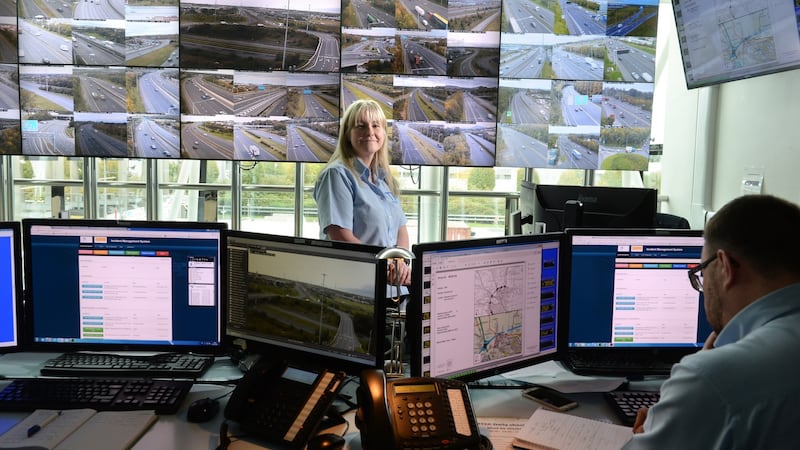
There is definitely a 7am rush hour now... It is people trying to avoid the traditional rush hour between 8.30am and 9am
In the past three years, as the economy has recovered and more people have returned to work, Clayton has seen the M50 become snarled up again by traffic. The last three Septembers have been horrendous, she says, as motorists contend with more work commuters and the return of the school run.
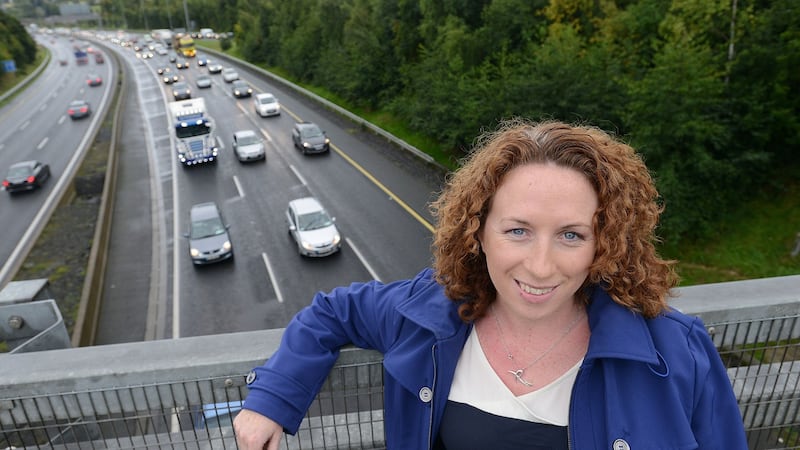
The economic improvement has seen the return of “White Van Driver Man” to our roads. Clayton (36) notices the tradesmen and the supermarket delivery trucks out in force again. And more people are on the road earlier in the day, she says.
“There is definitely a 7am rush hour now,” she says. “It is people trying to avoid the traditional rush hour between 8.30am and 9am. It is same going home. More people are doing weirder hours to avoid traffic and then we all end up sitting in traffic.”
After ten years of driving on the M50, Clayton knows the short cuts and “rat runs” that help her avoid some of the traffic. She listens to the traffic programme on Dublin City FM as soon as she gets into the car, to decide which one to take.
Tuesday mornings and Friday evenings are the worst, she says. People who only work four-day weeks are definitely on the road on Tuesdays. Clayton calls it “two-gear Tuesday” as she only moves between first and second gears. Leaving at 4pm on a Friday is “just insane”, she says, as it means contending with end-of-week traffic.
Clayton’s husband works in St Stephen’s Green. He takes the train into town every day. Clayton does not have the same choice. There is no direct public transport link from Celbridge to UCD.
“I don’t think there is any other option,” she says. “There is the one road that circles the city and that is it.”
A blocked artery
For tens of thousands of daily commuters, this is their M50 ordeal. “A highway to hell” as one commuter calls it. Others refer to the road as “Dublin’s biggest car park”. Motorists dread the sight of flashing blue lights or red brake lights in the distance or even drops of rain on their windscreen. It can mean gridlock.
The 45.5-kilometre stretch carries an average daily traffic of 142,496 vehicles, according to Transport Infrastructure Ireland (TII) and the National Transport Authority (NTA). This is up from 109,434 in 2009; a 30 per cent increase.
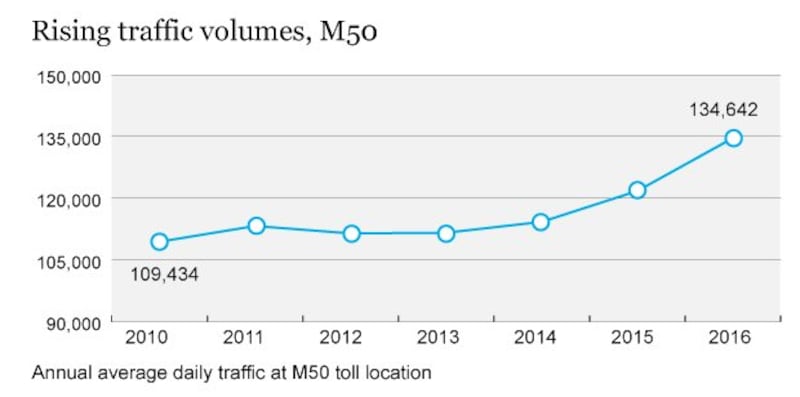
Traffic volumes are already close to predicted average for 2023 in a study completed three years ago.
Like a blocked artery in the body, an incident on a vital thoroughfare like the M50 can affect the flow elsewhere in the road network in and around Dublin, leading to tailbacks along other important routes in adjacent counties Kildare and Meath.
Heading north, 15 junctions spill traffic onto the M50; southbound, there are 16. The most congested stretch is between junction seven – the N4 road to Galway – and junction nine at the Red Cow – the interchange with the M7 which is the busiest feeder route bringing traffic from Limerick, Cork and Waterford.
Between two radial routes, 51 million journeys have been recorded, making the M50 by far Ireland busiest road.
To put it in context, the same number of vehicles used the George Washington Bridge connecting New Jersey and New York, with its population of 8.5 million, in 2016. Dublin, by contrast, has a population of 1.3 million. That number rises to almost two million people if the surrounding counties of Meath, Wicklow and Kildare are taken into account.
Closer to the M50, local traffic in and around Dublin adds to the congestion. There are, on average, 400,000 unique journeys on the M50 every day. These are motorists who drive two junctions or less.

The M50 is not alone in seeing increased traffic volumes. Ireland’s roads have become busier over the past five years as more people have found work. The number of workers commuting by car topped 1.3 million in 2016, up 8 per cent from five years earlier, according to last year’s census.
Dublin accounts for a huge share of these jobs. The city’s daytime working population passed the half-million mark in 2016 reaching 512,449 workers; five times more than the next biggest population centre (Cork with 102,139), reflecting its disproportionate pull.
This puts greater strain on a main orbital route like the M50.
In the case of the Dublin Port Tunnel, every month is our best month when it comes to vehicle traffic
New data shows that traffic on the road is getting busier and that people are leaving earlier and getting home later, to beat the traffic. This means rush hours are longer and the gap between them is busier too.
468 punctures
“Historically, there used to be a morning peak, an evening peak and an inter-peak. You had free flow through that inter-peak,” says Andrew O’Sullivan, a project manager on network operations at the TII.
“Now we find the level of travel in the inter-peak is significantly higher than it was years ago. There are more people travelling later to work to avoid the morning peak and people aren’t waiting until the evening peak.”
O’Sullivan is speaking in a meeting room in the Motorway Traffic Control Centre next to the city entrance to Dublin Port Tunnel at East Wall. The centre is responsible for monitoring and supervising more than 65 million vehicle journeys every year.
In the next room, a bank of TV screens pipes in live feeds from cameras inside the Dublin Port Tunnel (technically part of the M50) and the Jack Lynch Tunnel in Cork. The wall is alive with motion as cars and trucks fly across screens. These traffic volumes act as a real-time illustration of economic growth.
“If you watched tunnel traffic, you could have seen the economic crash coming. The traffic was a year ahead of the curve. You could see it just go chuck, chuck, chuck,” says Jeff Burt, the TII executive in charge of managing the tunnels, lowering his hand to show the decline.
Now, the reverse is the case.
“In the case of the Dublin Port Tunnel, every month is our best month when it comes to vehicle traffic. We just had the best July ever. It was the best August ever,” he says.
The transport experts who monitor traffic flows prefer not to talk in terms of capacity but in terms of “the level of service”. If there is lots of traffic, the “level of service diminishes significantly.”

In theory, the M50 has unlimited capacity. The route will still take you from A to B, but the time the journey takes might be longer. If more people take the M50 at a particular point, there is “flow breakdown”. This is happening more often.
“It is great that economic activity increases and if that continues, that problem will increase,” says O’Neill.
“It is still moving 51 million vehicles a year,” says O’Sullivan. “That is 10 journeys for every man, woman and child on the island of Ireland and a heap of them don’t live in Dublin.”
Between 2012 and 2016 increased traffic meant the average speed on the M50 from Tuesdays to Thursdays dropped from 90km/h to 80km/h for rush-hour morning, southbound traffic, according to TII data. Unpredictability has risen too: the variability of journey times during rush hours grew four-fold between 2012 and 2014 and has continued to grow, and indeed accelerate, since then.
“In simple terms, this means for commuters that the difference between a good day and a bad day on the M50 is much greater now than a number of years ago,” says Burt.
Figures provided by the NTA, based on travel times collected from satnav devices on a sample of cars, show that the M50 southbound has recorded the worst increases in travel times.
The average M50 journey time at the peak of the morning rush hour between 8am and 9am from the junctions with the M1 – the motorway to Belfast – in the north to the interchange with the M11 – the motorway to Wexford – in the south has doubled. In 2010, it took 28 minutes; it took 56 minutes in 2016.
The journey from junction three (the interchange with the M1) to junction six (the link to the M3 in Cavan) experienced the biggest increase in congestion, taking almost 17 minutes, compared with more than five minutes in 2010. The next worst was the section of the M50 to the Red Cow roundabout, which takes a similar amount of time to cover.
Heading north, it took 25 minutes to drive from the M11 to the M1 along the M50 six years ago; in 2016 it took 40 minutes with the journey from the junctions at Sandyford to the Red Cow recording the biggest increase in time.
Traffic times shared by TII shows that it currently takes just over an hour to travel around the M50 in the morning rush hour, peaking at 9am, and about 75 minutes in the evening, peaking just before 6pm.
Going the other direction, the traffic is less congested; it takes less than 40 minutes to travel this route heading northbound in the morning, peaking shortly after 8am, and just over 50 minutes in the evening, peaking before 6pm.
Down the corridor at the East Wall traffic centre, Michelle Malone, a supervisor in the traffic control centre, is monitoring about 60 cameras along the M50. It is mid-morning, traffic on all parts of the route is moving. It seems quiet.
“We don’t say the Q-word [quiet] here,” she says. “This time of day is usually good but you don’t ever say it.”
In the seven months to July there were 3,832 incidents – mostly breakdowns – affecting traffic along the M50, according to TII’s records. Some 1,600 involved breakdowns that did not require a Garda presence.
The average response time to start removing the vehicle was 14 minutes. Mechanical failure was to blame for 2,359 incidents. There were 574 accidents. There were 468 punctures or blowouts on tyres, while 237 motorists ran out of fuel.
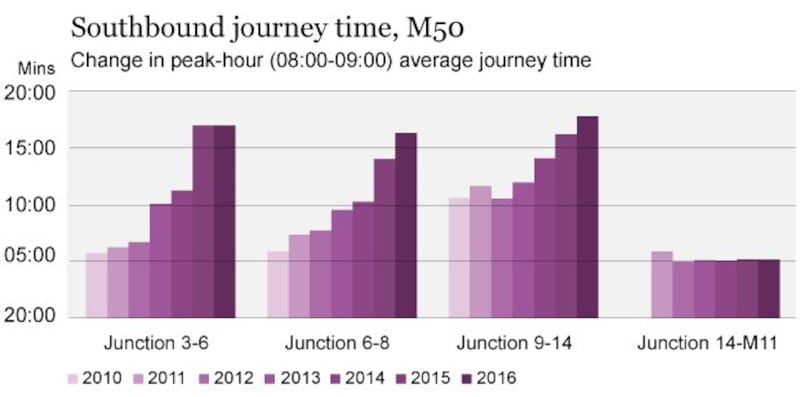
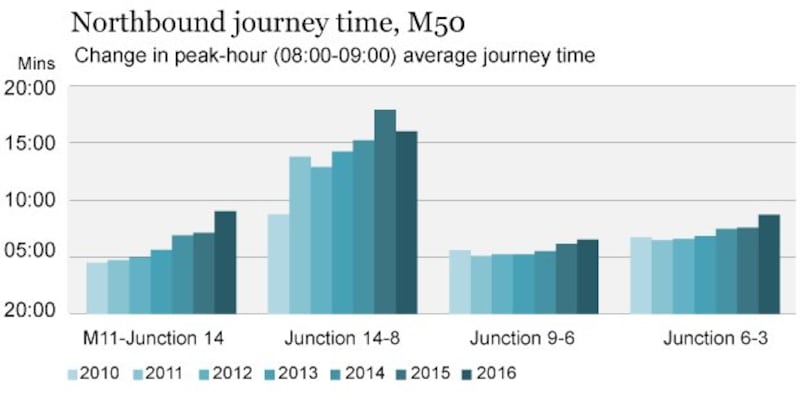
Malone has seen unusual things on her screens too. She once spotted a man on a mobility scooter going the wrong way up the on-ramp to the M50 at junction nine next to the Red Cow.
“People call it in and then we see it on the screen,” she says.
Traffic is worse in bad weather and when the schools are open but she admits it is always “very unpredictable.”
On one screen, a map of the northbound and southbound routes on the M50 changes to red when traffic jams up. The route usually turn red for both directions, even when the incident is only on one side.
“Ninety-nine per cent of the time it is rubber-necking on the far side,” says Malone. “When it turns red, we know exactly what it is. People see the flashing blues and they will stop to look.”
Talking and texting
For Brian Deane, a daily user of the M50 for 20 years, rubber-necking is something he sees regularly on his drive from home in Raheny to his IT company’s offices in Damastown and Blanchardstown in west Dublin.
“I accept that there is a natural tendency to slow down to see what has happened and that there is no real solution to this but boy does it cause delays,” says the 66-year-old businessman.
Deane believes the fundamental problem with congestion on the M50 is poor, unsafe driving and a failure of motorists to follow the rules of the road, such as using the outer lane as a passing lane only.
“Mobile phone usage is astonishing. There is never a day that goes by that I do not see large numbers of drivers using hand-held devices. They are talking with phones to their ears and often texting,” he says.
He thinks the number of emergency service vehicles that attend even relatively small collisions is excessive. Over a 12-day period, Deane says that on four mornings the M50 was “a car park” and 10 innocuous collisions brought out multiple emergency services vehicles. This led to long delays.
“The M50 is the most inconsistent and unreliable road in the country,” he says.
Poor driving irritates Lorraine Guildea too. She drives 54km twice a day from Stamullen in Co Meath down the M1, onto the M50 and around to her job in Citywest. It takes an hour each way on average.
“Some people don’t understand that just putting on your indicator doesn’t mean that you can move,” she says, puzzled by the risks motorists take just to get a few cars ahead in the traffic.
“People do mad things. The build-ups are always at the interchanges. Whatever way the interchanges are working, they are not really working,” she says.
Guildea (51) started her job in May and the M50 was her main concern when she did the interview. She looked for an additional €10,000 because of the commute. It will cover the €3,500 a year in tolls and fuel.
Her employer allows her to work flexible hours and one day at home. This helps her to avoid the worst of the daily traffic and keeps her sane. She shudders at the thought of doing the commute five days “when winter kicks in, in permanent darkness”.
Swans are the worst
It’s a Friday morning at Dublin City FM’s studio in the Dublin Incident and Traffic Control Centre and presenter Pam Duggan is reading out texts from commuters. Both Sacha and Yolande have texted in to say there say that there is a three-car collision on the M50 on the southbound lanes just before junction seven at Lucan.
“Sacha won that one,” says producer Heather MacLeod, pointing out how it sometimes seems like a competition among their regular listeners to inform the station of traffic hold-ups.
MacLeod reads out a message to researcher Thomas Bergin, to see whether the listener is accurate. They invariably are.
Bergin has 300 or so cameras at his control and has seen a lot on the monitors that stand in front of him. Mattresses, couches and ladders falling off trucks, dogs and horses on the road. “Swans,” he says, “give the most hassle.”
The programme broadcasts from 7am to 10am and again from 4pm to 7pm. There are plenty of regular texters popping up on the station’s WhatsApp screen, most of whom have their own nicknames: SkodaMan, N7Dec, Mr Chip & Booklady and El Gringo.
The traffic centre is located on the seventh floor of Dublin City Council’s offices on Wood Quay in the city centre. The team knows some of their listeners so well that they notice from their texts when their routes deviates.
“Once the clocks go back, that is when it starts getting bad,” says Duggan.
“When the traffic is really heavy, that is when the show comes into its own,” says Bergin, flashing through screen after screen on the look out for clusters of red brake lights.
This morning, a low, bright sun in a mostly cloud-free sky is causing tailbacks on the M50. Every few minutes, Duggan reads out the time it takes from "ball to cow". This is traffic-speak for the distance from the Perpetual Motion ball – the landmark roadside artwork in Naas – to the Red Cow roundabout at the M50.
Today, texters report, it never takes more than 17 minutes. It is not always this free-flowing. The previous Tuesday morning it was raining and “ball to cow” took motorists a stress-inducing 55 minutes, says Duggan.
“If you know how long you are going to be stuck in traffic, there is a comfort in it,” she says as a song plays. Chilled-out music works best before 7.30am. In the evenings, they pick upbeat tunes.
Daily monitoring of traffic has made the team keen observers of human behaviour. Most traffic jams at off-ramps on junctions such as at junction 14 in Sandyford are caused by queue-jumping motorists. “People think they are being smart cutting in but they are the reason that the queue is so bad,” says MacLeod.
Niall Bolger, a council executive and the liaison between the local authority and the LiveDrive team, explains the concept of "traffic memory": if everyone drives at the same, slow speed in heavy traffic, there is less braking and less rippling of stop-start traffic back along the route that slows everyone up. If motorists try to drive faster and have to brake constantly, it has a "memory effect" in the traffic, causing congestion further back. "It is people trying to get into a space that doesn't exist," he says.
Not enough road
“There are just too many cars and not enough road,” says Shane Hughes, who is in IT sales and commutes from his home in Tullamore to his office in Park West in west Dublin or to meetings in the city centre.
Hughes (33) drives more than 80km from Co Offaly before he reaches the M50 and the inevitable tailbacks caused by what he says is a mixture of congestion and people’s driving attitudes.
“The worse the traffic gets, the worse it is for driving, with people ducking in and out and you get little collisions. The driving I witness you can sense when something is going to happen because you can sense the behaviours of different drivers. They are pulling out at the last minute and slamming on their brakes,” he says.
M50 commuters offer different solutions to the gridlock: Lorraine Guildea believes cars should be able to come on to the M50 on multiple lanes so it does not slow traffic. She and other commuters believe there could be better a public transport along the M50 itself.
“There seems to be the same number of people going in both directions,” she says. “There is no public transport solution to the M50. In order to try to get west, the only option is the M50.”
Brian Deane suggests a ban on trucks between the hours of 7.30am and 9.30am, while better policing of the route would help prevent accidents due to mobile phone use.
“I honestly don’t know what the answer is bar building another M50,” says Deirdre Clayton.
This would involve returning to shelved plans for a Leinster Outer Orbital Route – essentially a bypass of the bypass – to the west of the M50. The M50 cannot be widened again. There is not enough room to add lanes and it cannot go double-decker, like some highways in the US, for example.
“The long-term solution for the M50 is integrating its operations with public transport, so that people have the opportunity to park and ride and take another form of transport,” says TII spokesman Seán O’Neill.
The next plan is to better manage the traffic on the M50 by installing about 400 electronic signs above the road called “automated motorway indicators”. These will allow the imposition of variable speed limits to slow everyone down in congested traffic. Reduced speeds even out the flow and stop a traffic jam getting worse.
The new signs, to be introduced in 2020, can also shut down lanes if there is an incident further ahead, to encourage motorists to move lanes earlier. “They act as visual traffic cones,” says O’Neill.
Another option to manage future traffic flows is variable, multi-point tolling: charging more in tolls for motorists’ junction-by-junction use of the M50. Right now, it is too hot politically, but it could be used to reduce traffic volumes in future should the route become too congested.
Longer term, rebalancing economic activity so that less of it takes place in Dublin would help the M50. “The country is like a seesaw: there is a big gorilla on the east side and a little duck on the west,” says O’Neill, though he acknowledges there are signs of growth outside Dublin.
The NTA sees part of the solution in greater investment in sustainable public transport, such as making Dublin’s bus system faster, more reliable and more convenient.
The authority is conducting further research to see what has changed about travel behaviour since 2012, including how long people are spending on the M50.
Until then, as winter approaches, M50 commuters will encounter more red brake lights in the rush-hour darkness and spend more hours behind the wheel. In other words, more M50 hell.
************************************
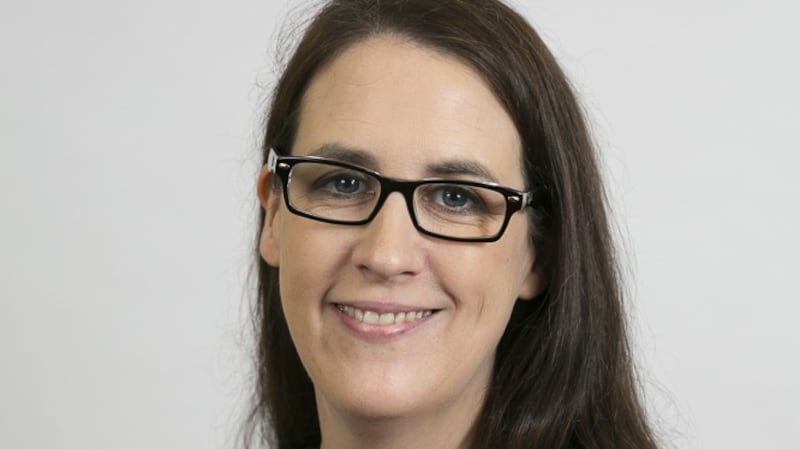
My M50: ‘It’s not the time. It’s the unpredictability’
Edel Griffith (43) has been commuting from Malahide to Leopardstown, around the M50, for her job in an engineering company since May. Flexible work hours allow her to set out at 6.20am three mornings a week. She usually reaches her office before 7am. On the return leg, she is gone by 3.45pm and ahead of the worst traffic.
Two mornings a week she drops her son to his preschool and heads to work at 9.15am. That is when she hits long delays on the M50. What is normally a 40-minute commute took her 75 minutes on two recent mornings.
“If it is anywhere near the Galway or Limerick exits, if you could turn around and go home, you would be better off – it is crazy,” she says. “In many respects, it is not the time but the unpredictability of it all.”
“A day doesn’t go by that I find myself sitting in the car, shaking my head,” she says. “A lot of the problems are [related to] driver behaviour: people just doing silly things to make up a couple of minutes here and there.”
Griffith is pretty sanguine about her commute. It is not nice but it is part of life, she says. She regularly jokes with commuting colleagues that they need to find “things to talk about that are not the M50 or traffic”.
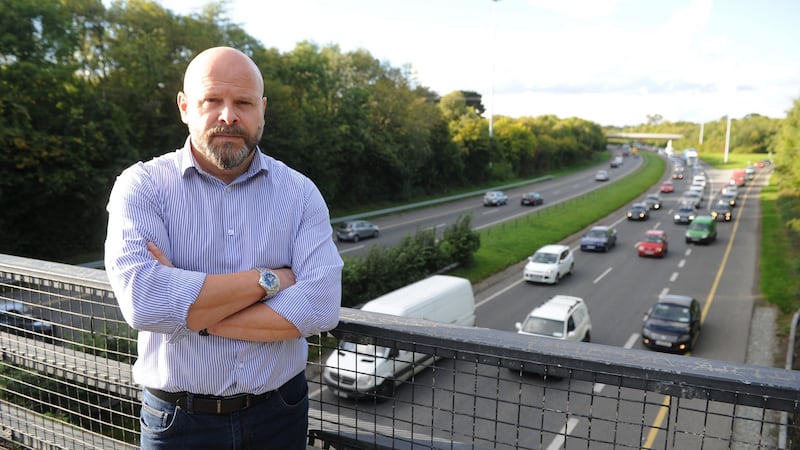
My M50: ‘We need a better communications system’
Peter Conneely is a heavy M50 user. He travels from his home in Bray, Co Wicklow, to his job in Glasnevin every day and takes the M50 most weeks for meetings around the city.
Leaving later in the mornings means longer journey times. Weather plays a huge part in traffic congestion, says Conneely, but there are also plenty of inexperienced drivers on the road; he spots lots of learner drivers with nobody in the passenger seat next to them. Then there are the “middle-lane or outside-lane huggers”.
He believes that electronic signs with variable speed limits will improve traffic flow. “We need a better communications system around there being an accident; where do I go and how do I get there?” he says.
The fact that Conneely (49), a business development manager, can mix up his hours and is not on the M50 at the most congested times of day helps him cope with the traffic.
“I don’t get too stressed about it; life is too short,” he says. “It is a matter of managing it.”










